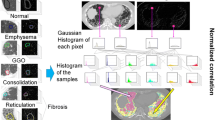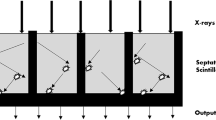Abstract
Objectives
To design and validate a scoring system for tomosynthesis (digital tomography) in pulmonary cystic fibrosis.
Methods
A scoring system dedicated to tomosynthesis in pulmonary cystic fibrosis was designed. Three radiologists independently scored 88 pairs of radiographs and tomosynthesis examinations of the chest in 60 patients with cystic fibrosis and 7 oncology patients. Radiographs were scored according to the Brasfield scoring system and tomosynthesis examinations were scored using the new scoring system.
Results
Observer agreements for the tomosynthesis score were almost perfect for the total score with square-weighted kappa >0.90, and generally substantial to almost perfect for subscores. Correlation between the tomosynthesis score and the Brasfield score was good for the three observers (Kendall’s rank correlation tau 0.68, 0.77 and 0.78). Tomosynthesis was generally scored higher as a percentage of the maximum score. Observer agreements for the total score for Brasfield score were almost perfect (square-weighted kappa 0.80, 0.81 and 0.85).
Conclusions
The tomosynthesis scoring system seems robust and correlates well with the Brasfield score. Compared with radiography, tomosynthesis is more sensitive to cystic fibrosis changes, especially bronchiectasis and mucus plugging, and the new tomosynthesis scoring system offers the possibility of more detailed and accurate scoring of disease severity.
Key Points
• Tomosynthesis is more sensitive than conventional radiography for pulmonary cystic fibrosis changes.
• The radiation dose from chest tomosynthesis is low compared with computed tomography.
• Tomosynthesis may become useful in the regular follow-up of patients with cystic fibrosis.









Similar content being viewed by others
References
Vikgren J, Zachrisson S, Svalkvist A et al (2008) Comparison of chest tomosynthesis and chest radiography for detection of pulmonary nodules: human observer study of clinical cases. Radiology 249:1034–1041
Vult von Steyern K, Bjorkman-Burtscher I, Geijer M (2011) Tomosynthesis in pulmonary cystic fibrosis with comparison to radiography and computed tomography: a pictorial review. Insights Imaging. doi:10.1007/s13244-011-0137-9
Shwachman H, Kulczycki L (1958) Long-term study of one hundred five patients with cystic fibrosis: studies made over a five- to fourteen-year period. AMA J Dis Child 96:6–15
Taussig L, Kattwinkel J, Friedewald W et al (1973) A new prognostic score and clinical evaluation system for cystic fibrosis. J Pediatr 82:380–390
Chrispin A, Norman A (1974) The systematic evaluation of the chest radiograph in cystic fibrosis. Pediatr Radiol 2:101–105
Brasfield D, Hicks G, Soong S et al (1979) The chest roentgenogram in cystic fibrosis: a new scoring system. Pediatrics 63:24–29
Van der Put J, Meradji M, Danoesastro D et al (1982) Chest radiographs in cystic fibrosis. A follow-up study with application of a quantitative system. Pediatr Radiol 12:57–61
Carty H (1987) The chest radiograph in cystic fibrosis in children and the role of other radiological techniques. J R Soc Med 80:38–46
Weatherly M, Palmer C, Peters M et al (1993) Wisconsin cystic fibrosis chest radiograph scoring system. Pediatrics 91:488–495
Conway S, Pond M, Bowler I et al (1994) The chest radiograph in cystic fibrosis: a new scoring system compared with the Chrispin-Norman and Brasfield scores. Thorax 49:860–862
Cleveland R, Neish A, Zurakowski D et al (1998) Cystic fibrosis: a system for assessing and predicting progression. AJR Am J Roentgenol 170:1067–1072
Koscik R, Kosorok M, Farrell P et al (2000) Wisconsin cystic fibrosis chest radiograph scoring system: validation and standardization for application to longitudinal studies. Pediatr Pulmonol 29:457–467
Benden C, Wallis C, Owens C et al (2005) The Chrispin-Norman score in cystic fibrosis: doing away with the lateral view. Eur Respir J 26:894–897
Bhalla M, Turcios N, Aponte V et al (1991) Cystic fibrosis: scoring system with thin-section CT. Radiology 179:783–788
Nathanson I, Conboy K, Murphy S et al (1991) Ultrafast computerized tomography of the chest in cystic fibrosis: a new scoring system. Pediatr Pulmonol 11:81–86
Maffessanti M, Candusso M, Brizzi F et al (1996) Cystic fibrosis in children: HRCT findings and distribution of disease. J Thorac Imaging 11:27–38
Santamaria F, Grillo G, Guidi G et al (1998) Cystic fibrosis: when should high-resolution computed tomography of the chest be obtained? Pediatrics 101:908–913
Brody A, Molina P, Klein J et al (1999) High-resolution computed tomography of the chest in children with cystic fibrosis: support for use as an outcome surrogate. Pediatr Radiol 29:731–735
Helbich T, Heinz-Peer G, Eichler I et al (1999) Cystic fibrosis: CT assessment of lung involvement in children and adults. Radiology 213:537–544
Robinson T, Leung A, Northway W et al (2001) Spirometer-triggered high-resolution computed tomography and pulmonary function measurements during an acute exacerbation in patients with cystic fibrosis. J Pediatr 138:553–559
Oikonomou A, Tsanakas J, Hatziagorou E et al (2008) High resolution computed tomography of the chest in cystic fibrosis (CF): is simplification of scoring systems feasible? Eur Radiol 18:538–547
Brody A, Klein J, Molina P et al (2004) High-resolution computed tomography in young patients with cystic fibrosis: distribution of abnormalities and correlation with pulmonary function tests. J Pediatr 145:32–38
Dobbins J, Godfrey D (2003) Digital x-ray tomosynthesis: current state of the art and clinical potential. Phys Med Biol 48:R65–R106
Bath M, Svalkvist A, von Wrangel A et al (2010) Effective dose to patients from chest examinations with tomosynthesis. Radiat Prot Dosim 139:153–158
Sabol JM (2009) A Monte Carlo estimation of effective dose in chest tomosynthesis. Med Phys 36:5480–5487
Reid L (1950) Reduction in bronchial subdivision in bronchiectasis. Thorax 5:233–247
Lynch D, Newell J, Hale V et al (1999) Correlation of CT findings with clinical evaluations in 261 patients with symptomatic bronchiectasis. AJR Am J Roentgenol 173:53–58
Barker A (2002) Bronchiectasis. N Engl J Med 346:1383–1393
Rossi S, Franquet T, Volpacchio M et al (2005) Tree-in-bud pattern at thin-section CT of the lungs: radiologic-pathologic overview1. Radiographics 25:789–801
Eisenhuber E (2002) The tree-in-bud sign. Radiology 222:771–772
Landis JR, Koch GG (1977) The measurement of observer agreement for categorical data. Biometrics 33:159–174
Svensson E, Holm S (1994) Separation of systematic and random differences in ordinal rating scales. Stat Med 13:2437–2453
Svensson E, Starmark JE, Ekholm S et al (1996) Analysis of interobserver disagreement in the assessment of subarachnoid blood and acute hydrocephalus on CT scans. Neurol Res 18:487–494
de Jong P, Lindblad A, Rubin L et al (2006) Progression of lung disease on computed tomography and pulmonary function tests in children and adults with cystic fibrosis. Thorax 61:80–85
de Jong P, Tiddens H (2007) Cystic fibrosis specific computed tomography scoring. Proc Am Thorac Soc 4:338–342
Swedish National Board of Health and Welfare (Socialstyrelsen) (2010) Ovanliga diagnoser, cystisk fibros. http://www.socialstyrelsen.se/ovanligadiagnoser/cystiskfibros. Accessed 15 June 2010
Aziz Z, Davies J, Alton E et al (2007) Computed tomography and cystic fibrosis: promises and problems. Thorax 62:181–186
Cooper P, MacLean J (2006) High-resolution computed tomography (HRCT) should not be considered as a routine assessment method in cystic fibrosis lung disease. Paediatr Respir Rev 7:197–201
Tiddens H (2006) Chest computed tomography scans should be considered as a routine investigation in cystic fibrosis. Paediatr Respir Rev 7:202–208
de Jong P, Nakano Y, Lequin M et al (2004) Progressive damage on high resolution computed tomography despite stable lung function in cystic fibrosis. Eur Respir J 23:93–97
Lucaya J, Piqueras J, Garcia-Pena P et al (2000) Low-dose high-resolution CT of the chest in children and young adults: dose, cooperation, artifact incidence, and image quality. AJR Am J Roentgenol 175:985–992
Acknowledgements
We thank Pär Wingren for his assistance in the development of the tomosynthesis scoring system, and Carina Fyledahl-Kastberg for invaluable help in performing the tomosynthesis examinations and keeping the patient log.
A scientific paper abstract with the title “A scoring system for tomosynthesis in pulmonary cystic fibrosis” was presented at ECR 2012 as an oral presentation (poster number: B-0417).
Author information
Authors and Affiliations
Corresponding author
Electronic supplementary material
Below is the link to the electronic supplementary material.
ESM 1
(PDF 5.02 mb)
Rights and permissions
About this article
Cite this article
Vult von Steyern, K., Björkman-Burtscher, I.M., Höglund, P. et al. Description and validation of a scoring system for tomosynthesis in pulmonary cystic fibrosis. Eur Radiol 22, 2718–2728 (2012). https://doi.org/10.1007/s00330-012-2534-y
Received:
Revised:
Accepted:
Published:
Issue Date:
DOI: https://doi.org/10.1007/s00330-012-2534-y




